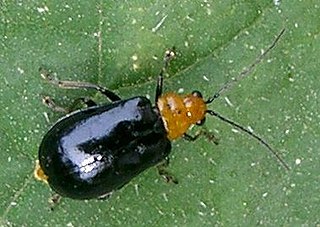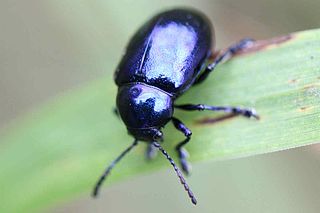
Micrathena, known as spiny orbweavers, is a genus of orb-weaver spiders first described by Carl Jakob Sundevall in 1833. Micrathena contains more than a hundred species, most of them Neotropical woodland-dwelling species. The name is derived from the Greek "micro", meaning "small", and the goddess Athena.

Aulacophora is a genus of beetles in the family Chrysomelidae, commonly known as pumpkin beetles; some species are pests of agricultural crops. The genus was named in 1836 by the French entomologist Louis Alexandre Auguste Chevrolat, in Dejean's Catalogue des Coléoptères. The name, from Ancient Greek, signifies "furrow-bearer"' from aulax, "furrow".

Brasiella is a genus of tiger beetles in the family Cicindelidae. There are more than 50 described species in Brasiella.

Ctenostoma is a genus in the beetle family Cicindelidae. There are more than 120 described species in Ctenostoma.

Bromius obscurus, the western grape rootworm, is a species of beetle in the leaf beetle family. It is the only member of the genus Bromius. The distribution of the species is holarctic; it can be found in North America, wide parts of Europe, and Asia. The species is a known pest of grape vines in Europe and western North America.

Platycorynus is a genus of leaf beetles in the subfamily Eumolpinae. It is distributed in Africa and Asia.

Chalepini is a tribe of leaf beetles in the family Chrysomelidae. There are at least 50 genera and 830 described species in Chalepini.

Eumolpini is a tribe of leaf beetles in the subfamily Eumolpinae. It is the largest tribe in the subfamily, with approximately 170 genera found worldwide. Members of the tribe almost always have a longitudinal median groove on the pygidium, which possibly helps to keep the elytra locked at rest. They also generally have a subglabrous body, as well as appendiculate pretarsal claws.

Chrysochus is a genus of leaf beetles in the subfamily Eumolpinae. It is known from North America, Europe and Asia.

Chrysochus asclepiadeus is a member of the leaf beetle subfamily Eumolpinae. It is considered the type species of the genus Chrysochus, though it has sometimes been placed within the genus Eumolpus. It is the only species of Chrysochus distributed in the western Palaearctic. It is mainly found in Europe, though it is also known from Kazakhstan and Turkey in Asia.
Longeumolpus is a genus of leaf beetles in the subfamily Eumolpinae. It is mainly found in South America, though the type species has also been reported from Martinique in the Lesser Antilles of the West Indies. The genus was established in 1960 by the Czech entomologist Bohumila Špringlová de Bechyně as a close relative of Eumolpus.
Jansonius is a genus of leaf beetles in the subfamily Eumolpinae. It is found in Chile and Argentina. It was formerly placed in the tribe Adoxini, section Myochroites, but is now placed in Nodinini, section Metachromites.

Bromiini is a tribe of leaf beetles in the subfamily Eumolpinae. The tribe contains approximately 120 genera, which are found worldwide. They are generally thought to be an artificial group, often with a subcylindrical prothorax without lateral ridges and covered with setae or scales.

Coelomera is a genus of beetles belonging to the family Chrysomelidae.












